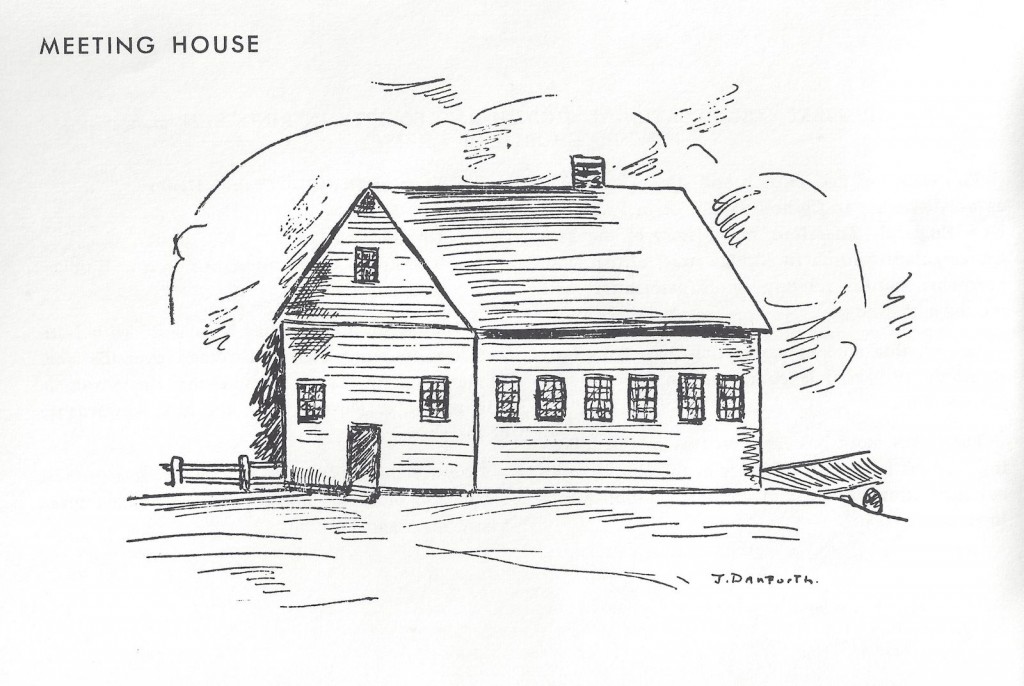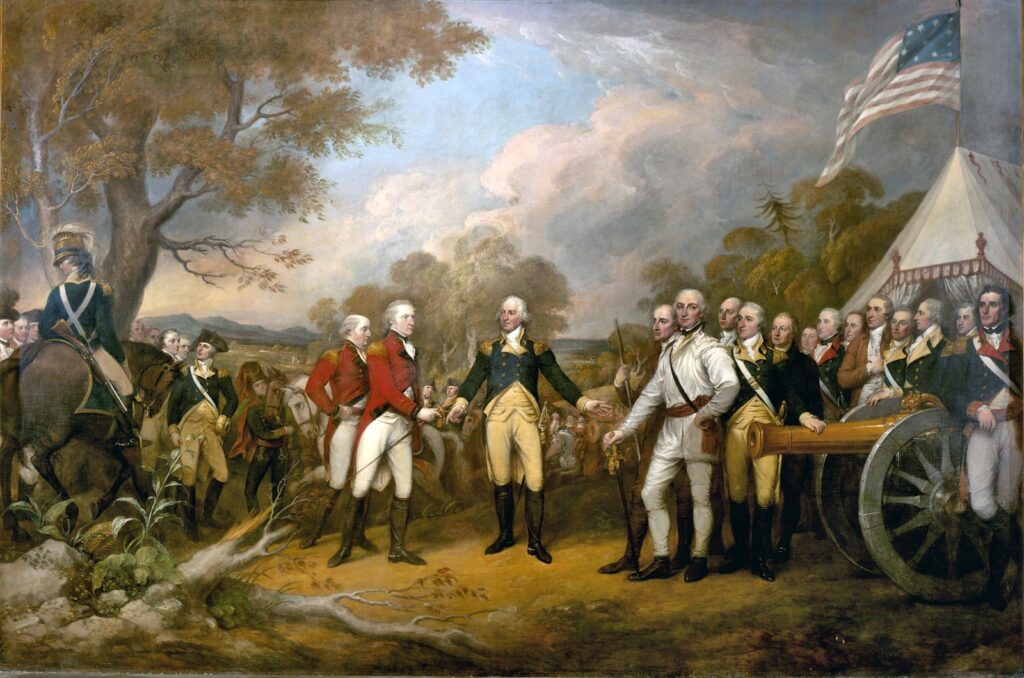Captain Abel Platts settles in Rindge. Credited as Rindge’s first temporary settler of European descent, Platts was forced to leave Rindge in the mid-1740s, but returned permanently with other early settlers in 1752
Rowley, Canada defined via survey. The township of Rowley Canada, comprising most of what is now Rindge, New Hampshire, was laid out (surveyed) for the first time.
Rowley renamed Monadnock No. 1. Rowley, Canada was re-granted in 1749 by Governor Benning Wentworth as Monadnock No. 1, or South Monadnock.
The first permanent settlers arrive. Among them was Abel Platts, who had originally settled in Rindge in 1738.

First Cemetery in Rindge Created. Rindge’s first cemetery, next to the First Rindge Meeting House, began operation in 1764.

On land set aside and cleared in 1765, the First Rindge Meeting House was completed. Beginning in 1766, public meetings of the proprietors were held in the meeting house. Learn more …
The town of Rindge is incorporated. Despite a request to name the town Providence, the town was given the name Rindge, likely in honor of Daniel Rindge, a member of the Provincial Council.
Rindge’s first Revolutionary War volunteers. On the afternoon of April 19, 1775, a rider arrived in Rindge, and before dawn the next day, 54 men assembled on the town common and marched off to Cambridge.

The Battle of Bunker Hill. Captain Philip Thomas, commanding a company of 51 men from Rindge in Colonel James Reed’s Regiment, is heavily involved in the thick of the battle, Jonathan Lovejoy, Isaac Adams, and George Carlton were killed in action, John Thomson was severely wounded. The British win the day while suffering heavy losses in killed and wounded.
Rindge unanimously votes in favor of the Association Test. Learn more …

The Battle of Bennington. Captain Salmon Stone commanded a company of 24 Rindge men in Colonel Nichols’ Regiment. General Stark’s Brigade was engaged in surprise attack on the rear of the enemy and won the day in what became a brilliant victory for the Colonial Army. Abel Perkins, overcome with heat exhaustion, died two days after the battle.

The Battle of Saratoga. Captain Daniel Rand commanded a company 24 Rindge men in Colonel Daniel Moore’s Regiment with the Continental Army under General Horatio Gates. The Continental Army defeat the British Army of General Burgoyne, who surrenders his entire Army on October 17, 1777.

Former Slave Tobias Cutler Serves in the 2nd New Hampshire Regiment. A former slave of Enoch Hale, Cutler enlisted during the winter months of early 1781 and served until sometime in 1784. The town’s vote that Tobe be received and deemed a legal inhabitant of Rindge, contingent upon his being granted his freedom, was the last reference to slavery found in the Rindge Town records. After the war, Tobias Cutler settled in Exeter.

Spotted Fever Outbreak Claims Victims in Rindge. Between November 25, 1811 and May 11, 1812, at least eight residents of Rindge, including two young daughters of Dr. Thomas Jewett, were killed by an outbreak of Spotted Fever (known in present times as cerebro-spinal-meningitis). See more at Find-a-Grave …
Colonel Ezekiel Jewett and the War of 1812. Colonel Jewitt, born in Rindge on Oct. 16, 1791, fought in several prominent battles in the War of 1812 against the British. Learn more …
First Methodist Church Constructed. The first Methodist Church constructed in Rindge was in the northwest corner of the town, on property previously owned by Moses Garfield. The location, distant from Rindge Center, was chosen to accommodate worshipers from the adjoining towns of Fitzwilliam and Jaffrey.
A Second Methodist Church Constructed in Rindge Center. The Methodist Episcopal Society of Rindge, formed the year before in 1834, built their church in Rindge Center in 1835, where it remained until 1882, when the building was moved to its present location in West Rindge. It is now known as the West Rindge Methodist Church.
Historian and Author Ezra S. Stearns Born in Rindge. On September 1, 1838, Ezra Scollay Stearns was born in Rindge. Mr. Stearns, the prolific historian who publishes several town histories, including “Stearns History of Rindge, New Hampshire”, was also a genealogist, teacher, newspaper editor, and politician. He served in the New Hampshire legislature from the age of 26, and was the Secretary of State of New Hampshire from 1891 to 1899. In addition, he was the town moderator for Rindge, NH, for more than 20 years. Learn more …
Smallpox Outbreak. Isaac Wood and his son Elbridge, victims of the 1848 smallpox outbreak, are buried in the Wood Cemetery, which is located along the Eversource power line right-of-way, some distance north of State Route 119.
Farewell to Rindge members of the 6th New Hampshire Regiment. A large number of residents along with many of their soldier boys gathered at the Meeting House for the presentation of a sword to Capt. Ebenezer Converse. Stephen B. Sherwin the esteemed town resident presided at this meeting on the eve of the departure of so many townsmen. Learn more …
Former Rindge Resident Elvira E Gibson becomes first female chaplain in the military. Elvira (Ellen) Gibson, who was raised in Rindge and later taught school there for several years, was appointed Chaplain to the 1st Wisconsin Heavy Artillery Unit in 1864. In 2013, after obtaining approval from the United States Department of Veteran’s Affairs, a memorial marker (pictured) was placed in the Rindge Cemetery. Learn more …
Monadnock Railroad Construction Begins. This project for a line from Winchendon to Peterborough was financed as a speculative venture. Jaffrey, Peterborough, and Winchendon used public funds, and along with private donations, the entire line was funded for $300,000.

The Cheshire Place Farming Complex is Constructed in East Rindge. Learn more …
The Medium’s Camp Meeting of the Two Worlds, of Rindge, N.H. Incorporated. Founded to advance the mediumship and the doctrines and facts of Modern Spirtualism, and to provide summer homes for the spiritualists. Located on Lake Contoocook, which was known at that time as Lake Sunshine.
Ingalls Memorial Library Constructed. The Ingalls Memorial Library was built in 1894 and dedicated in 1895. This Victorian building was constructed with funds provided by The Honorable Rodney Wallace, and was named in honor of his wife’s family
The Telephone Arrives in Rindge. The first telephone exchange in Rindge in 1905 was located at what was then the Thrasher Hotel, and had just twenty-eight subscribers. Electrical power to run the phone was initially provided by magneto, meaning the power was generated by the caller turning the hand crank on the telephone instrument.
Fence Encircling Town Common Completed. Although the fence around the town common no longer exists, it’s construction around the turn of the 20th century was a welcome addition to the town center.
East Rindge Chapel Constructed. Built to serve the needs of East Rindge Village, the chapel was operated by the East Rindge Sabbath School Association. The building is now a private residence.
Spectacular Fire Destroys the First West Rindge Railway Station. In 1916, the original West Rindge Railway Station was destroyed by fire. A second railway station (pictured) was built to replace the original.
Electricity Comes to Rindge. At the 1916 town meeting, it was voted to appropriate funds for a municipal electrical system (Rindge Electric Company).
Annett State Forest Acquired by New Hampshire State Park System. Albert Annett, Jaffrey native and President of the Annett Box Company, deeded to the State of New Hampshire as a State Forest Reservation 1,092 acres known as the Annett State Forest, in part a gift and the rest at a nominal consideration.
The Great Fire. A fire broke out in the barn of E. A. Fuller’s Store on the common. When the flames finally subsided, the destruction tally was as follows: the barn, Fullers House and store (which contained the post office), the house and barn of James Danforth and Konsta (Tommy) Pentilla’s house, barn and garage. Learn more …
Tornado Devastates West Rindge. On September 13, 1928 a tornado devastates the village of West Rindge. Scores of buildings damaged; woodlands ruined, basket company leveled. Learn more …
Civilian Conservation Corps at Camp Annett. On June 5, 1933, the 118th Company of the Civilian Conservation Corps arrived at what is now Annett State Forest Park – at that time called “Camp Annett.” Closed in June of 1937, the camp was reopened following the hurricane of 1938, and ultimately was closed for good in 1940. Learn more …
The Great New England Hurricane of 1938. While much of New Hamsphire was spared significant damage from the storm, which tracked to the west through Vermont, the towns of the Monadnock region suffered significant damage.
Cathedral of the Pines Dedicated. Built in honor of Lt. Sanderson Sloane, who was killed when his plane was shot down over Germany in 1944, Cathedral of the Pines is a national memorial dedicated to the memory and honor of all Americans who serve the nation. For more information, visit the Cathedral of the Pines Website.
Rindge Memorial School Opens. The current elementary school in Rindge, Rindge Memorial School, began operation.
New Post Office Building Constructed Near Rindge Center. The building currently services as the Rindge Police Station.
Rindge Telephone Service Converts Completely to Dial Equipment. The full conversion to dial phone service in 1962 meant the end of the road for the telephone operators of Rindge (at that time, Laura Baldwin, Ruth Ford, Hazel Kennedy, Dorothy Pangborn, and Barbara Rice).
Franklin Pierce College Chartered by the State Legislature. Franklin Pierce College, founded by Frank DiPietro, was originally located in the Rindge town center. Dr. DiPietro also purchased the land overlooking Pearly Pond, where the University’s campus is currently located. Visit the university’s website for more information on the history of Franklin Pierce University.
Franklin Pierce College Relocates. Newly established Franklin Pierce College relocates from the town center to a new site on Pearly Pond

Janis Joplin and the Kozmic Blues Band Appear in Concert at Franklin Pierce College. Albert Grossman booked the show in Rindge to serve as a live sound test ” … in the most obscure venue we could find.”
Reroute of Route 202 Bypasses Rindge Center. State Route 202 was rerouted to the west of its previous location from just north of the Massachusetts border to just north of the junction of Route 119.
Market Basket Opens. Market Basket Plaza, the first major commercial area in Rindge, located south of Route 119 on Route 202, opens.
Rindge Post Office Relocates. The Rindge Post Office relocates from Main Street to a newly constructed facility on Route 119. The Main Street location eventually becomes the Rindge Police Station.
The Village Grocer Closes. Located on the Rindge Town Common, The Village Grocer shutters its doors for good in 1995.
Ice Storm of 2008 Causes Heavy Damage in Rindge. On December 11, 2008, a devastating winter ice storm hit much of New England. Rindge was particularly hard hit.
The Former Pinecroft Inn of East Rindge Demolished. Originally the Commonwealth Hotel and later the Pinecroft Inn, the structure which was uninhabited and in very poor condition, was demolished. The former hotel was the last remaining evidence of East Rindge’s role as a tourist/holiday destination in the late nineteenth and early twentieth century.
The Bond for Consolidated Fiber Internet Passes. The town of Rindge passes Warrant Item #2, which ultimately results in the opportunity for everyone in Rindge to have high-speed, fiber-optic internet service at their home or business.
